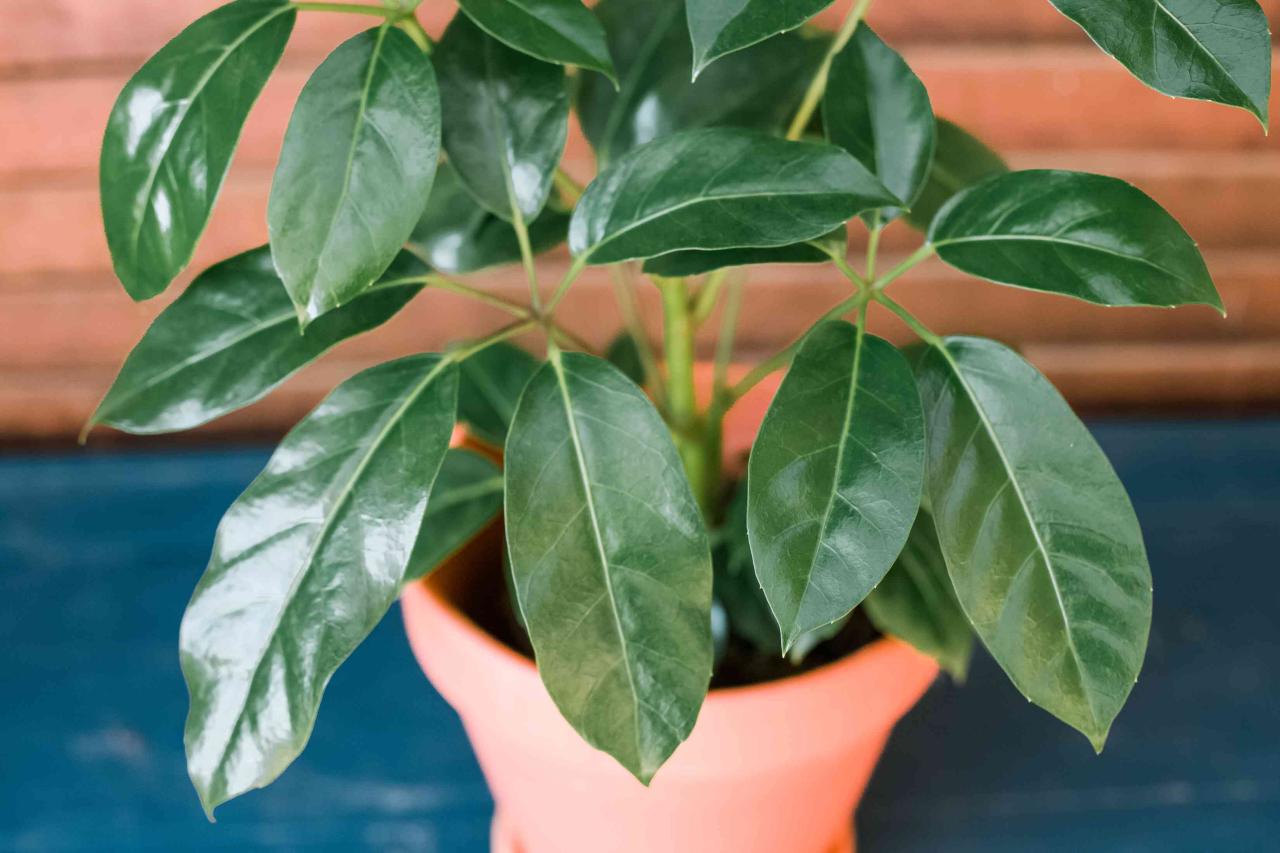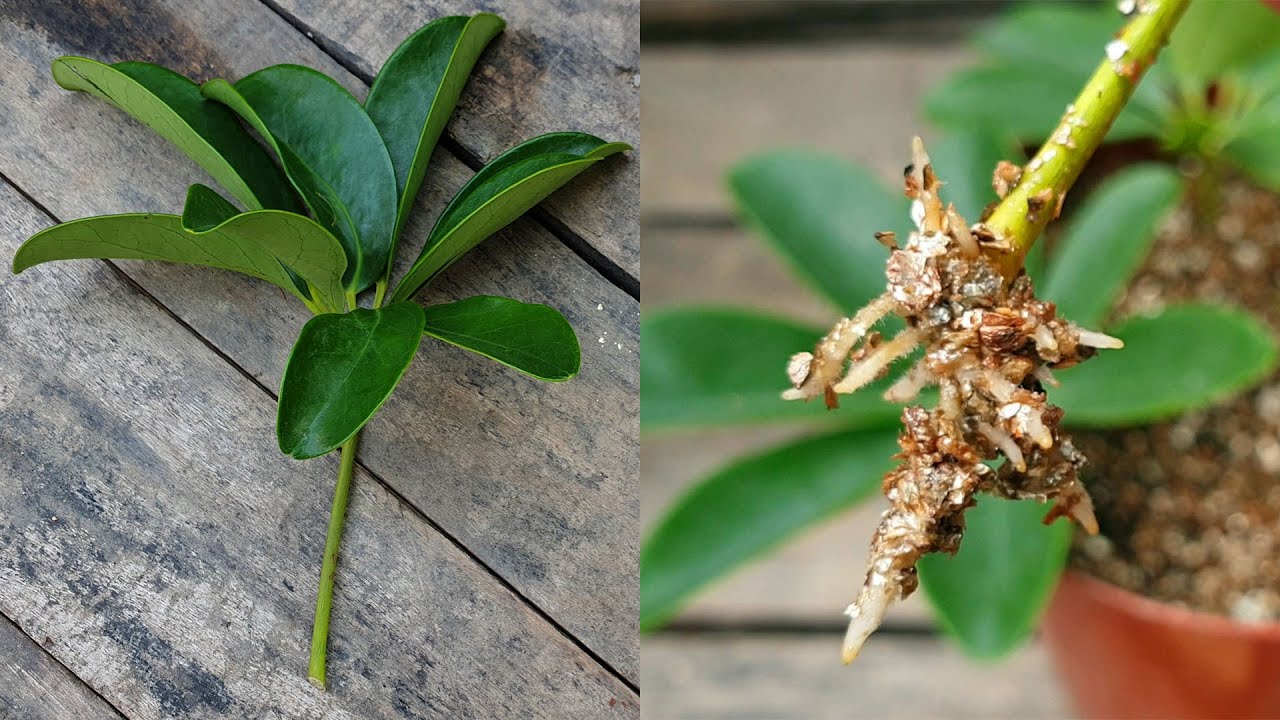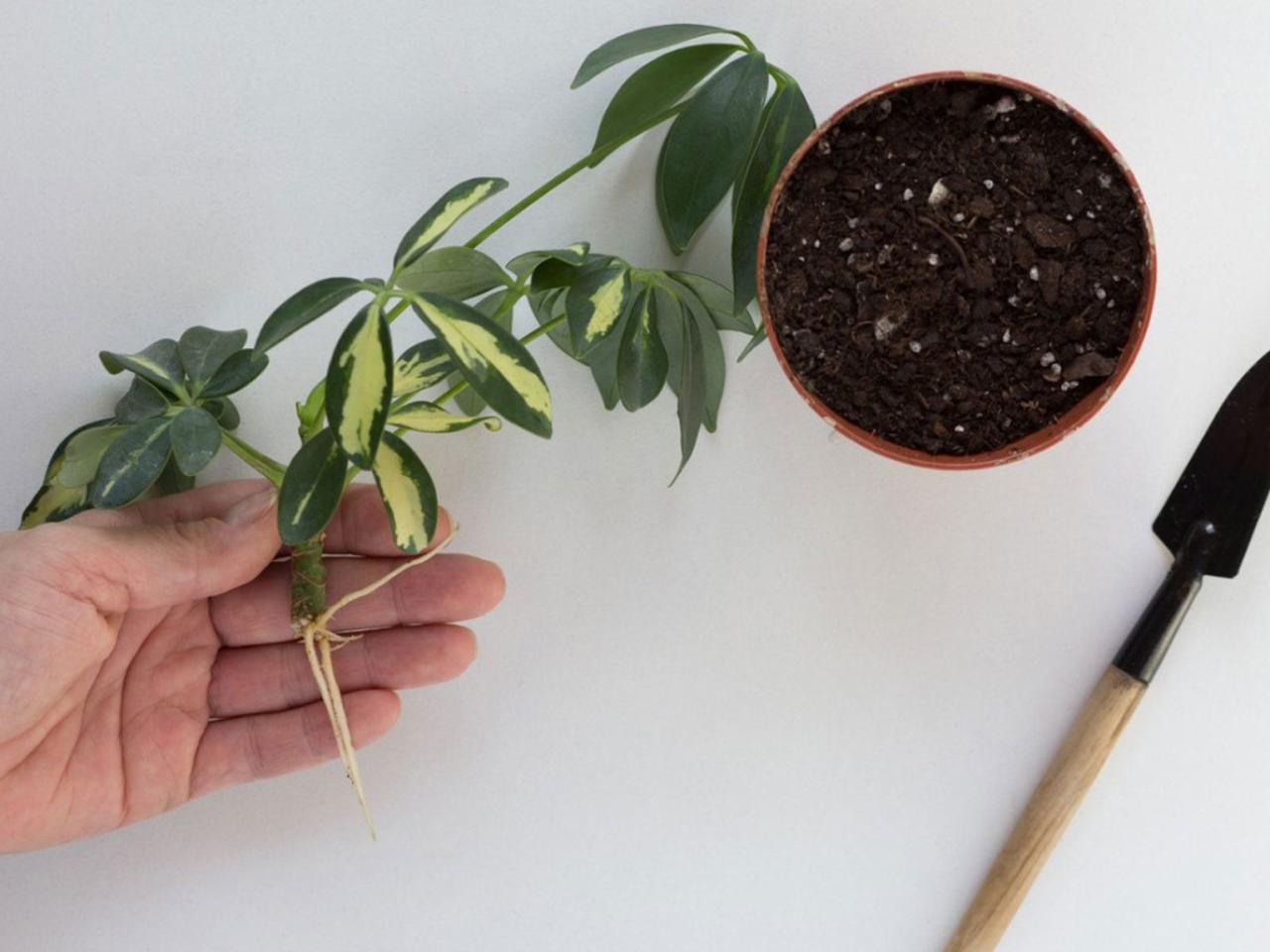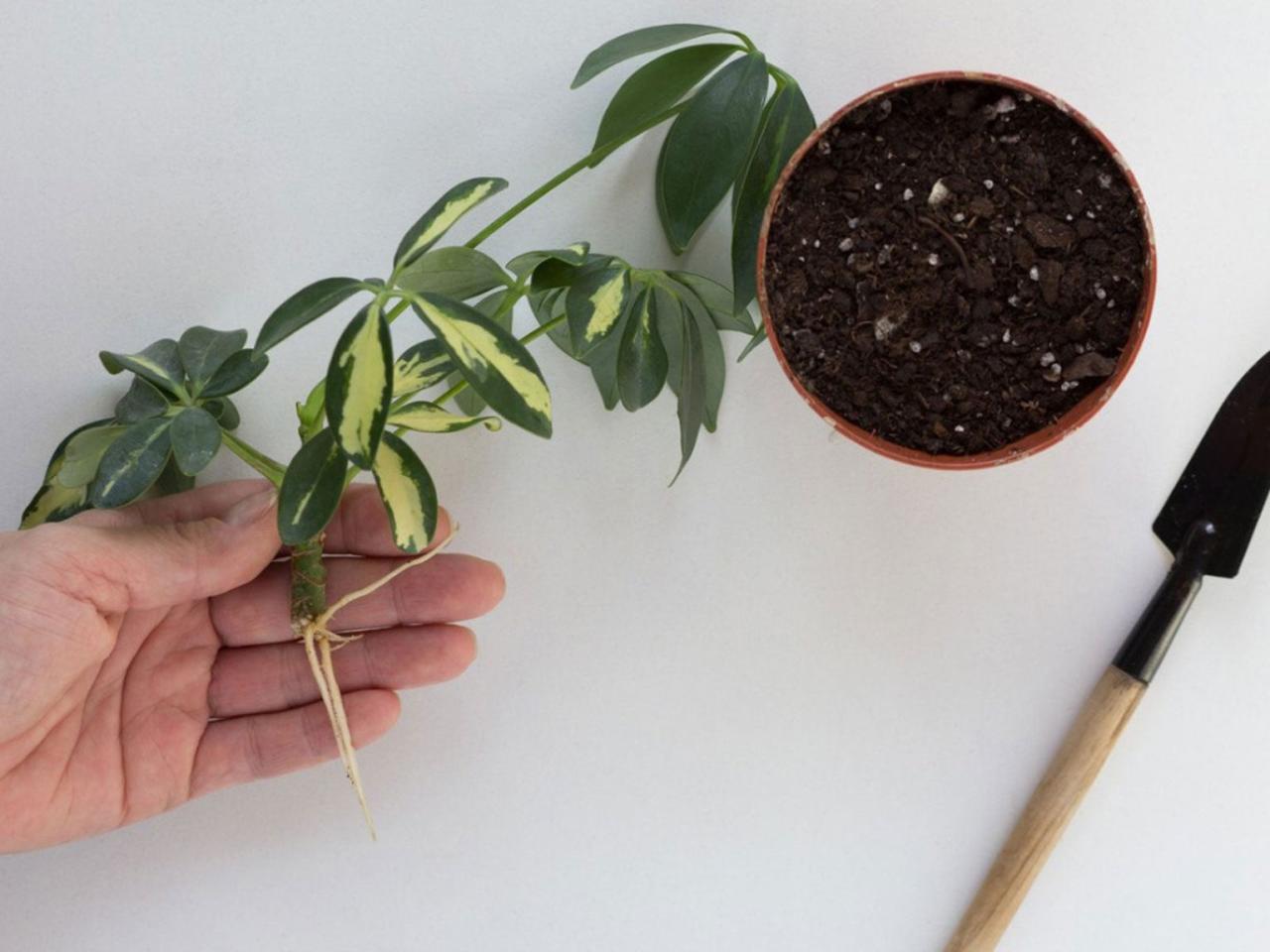The Essential Guide to Propagating Schefflera for Plant Enthusiasts, unlocks the secrets of multiplying these popular houseplants. Whether you’re a seasoned gardener or a curious beginner, this comprehensive guide will empower you to successfully propagate Schefflera, expanding your collection and sharing the joy of these vibrant plants with others.
Schefflera, also known as the umbrella plant, is a versatile and attractive houseplant that adds a touch of tropical charm to any space. Its lush, feathery foliage comes in various shades of green, making it a visually appealing addition to homes and offices.
But beyond its aesthetic appeal, Schefflera is also a relatively easy plant to propagate, making it a rewarding project for plant enthusiasts of all levels.
Introduction to Schefflera Propagation
Schefflera propagation is a rewarding and relatively straightforward process that allows plant enthusiasts to expand their collections or share their love of these beautiful plants with others. Propagating Schefflera offers numerous benefits, from creating new plants for free to experimenting with different varieties.
Mastering the art of propagating Schefflera plants is a rewarding endeavor for any plant enthusiast. While you’re expanding your plant family, consider taking a break and visiting a place where nature’s bounty is celebrated, like Why Harvest Moon Orchard Should Be on Your Bucket List This Year.
Upon your return, you’ll be even more inspired to nurture your Schefflera cuttings and watch them flourish into thriving plants.
This guide will delve into the world of Schefflera propagation, providing you with the knowledge and techniques to successfully grow new plants from cuttings or seeds.
Schefflera, commonly known as the umbrella tree or the dwarf umbrella tree, is a popular houseplant appreciated for its attractive foliage and adaptability. Native to tropical and subtropical regions, Schefflera boasts large, compound leaves that resemble an open umbrella, hence its common name.
These plants thrive in bright, indirect light and well-draining soil, making them relatively easy to care for indoors.
Methods of Schefflera Propagation
Schefflera propagation can be achieved through various methods, each with its own advantages and considerations.
The most common and successful method is through stem cuttings, which involve taking a section of healthy stem and encouraging it to develop roots. Another method is air layering, a technique that involves stimulating root growth on a stem while it’s still attached to the parent plant.
While less common, Schefflera can also be propagated from seeds, although this method may take longer and requires more patience.
- Stem Cuttings:This method involves taking a section of healthy stem, typically 4-6 inches long, and placing it in a rooting medium to promote root development. Stem cuttings are generally considered the easiest and most reliable method for propagating Schefflera.
- Air Layering:Air layering involves stimulating root growth on a stem while it’s still attached to the parent plant. This technique is particularly useful for propagating Schefflera with thick stems or those that are difficult to root from cuttings.
- Seed Propagation:Schefflera seeds can be collected from mature plants and sown in a seed-starting mix to produce new plants. While this method is less common, it can be a rewarding way to propagate Schefflera, especially for those interested in growing new varieties or experimenting with different cultivars.
Propagation by Stem Cuttings
Stem cuttings are a popular method for propagating Schefflera plants. This technique involves taking a section of a stem and encouraging it to develop roots, eventually forming a new plant. The process is relatively straightforward and offers a high success rate when performed correctly.
Taking Stem Cuttings
The ideal time to take stem cuttings is during the spring or early summer when the plant is actively growing. This is when the plant’s hormones are at their peak, promoting faster root development.
Preparing the Cuttings
- Select healthy, mature stems from your Schefflera plant.
- Use a sharp, sterilized knife or pruning shears to make a clean cut just below a leaf node, which is the point where a leaf grows from the stem.
- Remove the lower leaves from the cutting, leaving 2-3 leaves at the top. This reduces water loss and helps focus energy on root development.
- Dip the cut end of the stem in rooting hormone powder. This helps to stimulate root growth and increases the chances of successful propagation.
Rooting Medium
A well-draining rooting medium is crucial for Schefflera cuttings.
- A mixture of peat moss and perlite is ideal, as it retains moisture while providing good aeration.
- Alternatively, you can use a commercial rooting mix designed for cuttings.
Planting the Cuttings
- Fill a small pot or propagation tray with the rooting medium.
- Make a small hole in the medium using a pencil or your finger.
- Insert the prepared cutting into the hole, ensuring that the cut end is completely covered with the medium.
- Gently firm the medium around the cutting to ensure good contact.
Creating a Humid Environment
Maintaining high humidity is essential for successful rooting.
- Cover the pot or tray with a clear plastic dome or bag to create a humid environment.
- This will trap moisture and prevent the cuttings from drying out.
- Place the pot or tray in a warm, bright location, but avoid direct sunlight, which can overheat the cuttings.
Light and Temperature
Schefflera cuttings require bright, indirect light for optimal root development. Avoid direct sunlight, as it can scorch the leaves.
- An ideal temperature range for rooting is between 65-75°F (18-24°C).
- Maintain a consistent temperature to encourage healthy root growth.
Signs of Successful Rooting
After a few weeks, you should start to see signs of successful rooting.
- New growth emerging from the top of the cutting indicates that roots are forming.
- You can also gently tug on the cutting to check for resistance. If the cutting feels firmly rooted, it is ready to be transplanted into a larger pot.
Propagation by Air Layering

Air layering is a technique that involves encouraging roots to develop on a branch while it’s still attached to the parent plant. This method offers several advantages, particularly for Schefflera, a genus known for its woody stems. Air layering allows you to propagate a plant without disturbing the parent plant’s root system, which can be beneficial for large or delicate specimens.
Preparing the Branch for Air Layering
Selecting the right branch is crucial for successful air layering. Choose a healthy, mature branch that’s about the thickness of a pencil. The branch should be flexible enough to bend without snapping. Before proceeding, sterilize your tools with rubbing alcohol to prevent the introduction of any harmful bacteria or fungi.
- Make a Cut:Using a sharp knife or pruning shears, make a cut into the branch, about 1-2 inches long and halfway through the stem. This cut will encourage the formation of roots.
- Remove Bark:Carefully remove a strip of bark, about 1-2 inches long, from the area around the cut. This exposes the cambium layer, which is responsible for root growth.
- Apply Rooting Hormone (Optional):You can apply a rooting hormone powder to the exposed cambium layer to stimulate root development. However, this step is not essential for Schefflera.
Materials and Rooting Medium
To create a humid environment for root development, you’ll need the following materials:
- Sphagnum Moss:This highly absorbent moss provides a moist and airy environment for root growth.
- Plastic Wrap:Clear plastic wrap will help seal the moisture within the rooting medium.
- Twine or String:This will be used to secure the plastic wrap around the branch.
- Rooting Medium (Optional):While sphagnum moss is often used, you can also use a mixture of peat moss and perlite as a rooting medium.
Wrapping the Branch and Creating a Humid Environment
- Wrap the Branch:Dampen the sphagnum moss thoroughly and wrap it around the exposed cambium layer, ensuring the cut area is fully covered.
- Seal the Moss:Cover the moss with a layer of plastic wrap, securing it tightly around the branch with twine or string. Make sure the plastic wrap is snug but not constricting.
- Maintain Humidity:Keep the sphagnum moss moist by misting it regularly with water. Avoid overwatering, as this can lead to rot.
Signs of Successful Rooting
After a few weeks, you should start to see signs of root development. The following indicate successful rooting:
- New Growth:The branch may start to produce new leaves or shoots.
- Firmness:The branch will feel more robust and less likely to bend or break.
- Roots Visible:If you gently remove the plastic wrap, you may be able to see roots emerging from the cut area.
Propagation by Seed

While Schefflera can be propagated through seeds, it’s not the most common method for home gardeners. The process is more time-consuming than cuttings or air layering, and the resulting plants may not be identical to the parent plant. However, if you have access to seeds or want to experiment, it’s a feasible option.
Collecting and Preparing Schefflera Seeds
Schefflera seeds are small, round, and black. They are found within the fleshy fruit that the plant produces. The fruit ripens to a reddish-purple color before the seeds are ready for collection.
- To collect seeds, allow the fruit to fully ripen on the plant. Then, carefully remove the fruit and gently squeeze it to extract the seeds.
- Rinse the seeds in water to remove any remaining pulp.
- Allow the seeds to dry completely before storing them in a cool, dry place.
Growing Conditions for Schefflera Seedlings
Schefflera seedlings require warm temperatures and consistent moisture to germinate.
- A warm, sunny location is ideal for planting Schefflera seeds.
- Use a well-draining potting mix that retains moisture but doesn’t become waterlogged.
- Sow the seeds about 1/4 inch deep in the potting mix and water gently.
- Maintain a consistent temperature of around 70-75°F (21-24°C) to encourage germination.
- Keep the potting mix moist but not soggy.
Nurturing Schefflera Seedlings
Once the seedlings emerge, provide them with adequate light and water to promote healthy growth.
- Place the seedlings in a bright location, but avoid direct sunlight, which can scorch delicate leaves.
- Water the seedlings regularly, allowing the soil to dry slightly between waterings. Avoid overwatering, which can lead to root rot.
- As the seedlings grow, thin them out, leaving the strongest ones to continue developing.
- Once the seedlings have a few sets of true leaves, they can be transplanted into individual pots.
- Continue to provide them with consistent light and water, and fertilize them regularly to encourage robust growth.
Troubleshooting and Care
Propagating Schefflera, while generally straightforward, can present challenges. Recognizing common issues and implementing preventive measures are crucial for successful propagation. This section will address potential difficulties and offer solutions to ensure healthy growth of your newly propagated Schefflera plants.
Common Issues and Solutions
Identifying and addressing common issues during Schefflera propagation is vital for success. These issues can range from root rot to insufficient light, each affecting the plant’s growth and health.
- Root Rot:Overwatering is a primary cause of root rot. Symptoms include wilting leaves, yellowing foliage, and a mushy root system. To prevent root rot, use well-draining potting mix and ensure the soil dries slightly between waterings. If root rot occurs, remove the affected plant from the soil, trim away the damaged roots, and repot in fresh, sterile soil.
- Fungal Diseases:Damp conditions can lead to fungal diseases like leaf spot or powdery mildew. These diseases appear as spots or powdery coatings on leaves. Maintaining good air circulation and avoiding overwatering can prevent fungal diseases. If they occur, remove infected leaves and treat with a fungicide.
- Pest Infestations:Common pests include spider mites, mealybugs, and aphids. These pests can damage leaves and stunt growth. Regularly inspect plants for signs of infestation. Use insecticidal soap or neem oil to control pests.
- Insufficient Light:Schefflera requires bright, indirect light. Insufficient light can lead to leggy growth and pale foliage. Ensure the plant receives adequate light, especially during propagation.
- Temperature Fluctuations:Schefflera thrives in temperatures between 65°F and 75°F. Sudden temperature changes can stress the plant and hinder growth. Provide a stable environment with minimal fluctuations.
Watering and Fertilization
Proper watering and fertilization are essential for the healthy growth of newly propagated Schefflera plants.
- Watering:Allow the soil to dry slightly between waterings to prevent root rot. Overwatering is a common issue, leading to root damage. Use a finger test to check soil moisture. If the top inch of soil feels dry, water thoroughly.
- Fertilization:Newly propagated Schefflera plants need regular fertilization to provide essential nutrients for growth. Use a balanced liquid fertilizer diluted to half strength every two weeks during the growing season (spring and summer). Reduce fertilization during the winter months.
Acclimation, The Essential Guide to Propagating Schefflera for Plant Enthusiasts
Acclimating newly propagated Schefflera plants to their permanent location is crucial for their survival and healthy growth. Gradually introduce the plants to their new environment to prevent shock.
- Hardening Off:Before moving plants outdoors, gradually acclimate them to outdoor conditions. Start by placing them in a shaded area for a few hours each day, gradually increasing the exposure time over a week or two. This process, known as hardening off, helps the plants adjust to the changes in light, temperature, and humidity.
- Indoor Placement:When placing newly propagated Schefflera plants indoors, choose a location with bright, indirect light and avoid drafts. Gradually introduce them to their permanent location, ensuring they receive adequate light and humidity.
Types of Schefflera for Propagation
The Schefflera genus is diverse, with numerous species and cultivars, each possessing unique characteristics and propagation preferences. Understanding the different types of Schefflera and their preferred propagation methods is crucial for successful propagation.
Schefflera Types and Propagation Methods
The table below Artikels some common Schefflera types and their preferred propagation methods. It’s important to note that while these methods are generally successful, individual variations may exist, and experimentation is often recommended for optimal results.
Schefflera Type |
Characteristics |
Preferred Propagation Methods |
Additional Notes |
|---|---|---|---|
Schefflera arboricola (Dwarf Umbrella Tree) |
Compact, with glossy, dark green leaves. |
Stem Cuttings, Air Layering |
Popular houseplant; readily propagates. |
Schefflera actinophylla (Australian Umbrella Tree) |
Tall, with large, umbrella-shaped leaves. |
Stem Cuttings, Air Layering |
Hardy, tolerant of various conditions. |
Schefflera venulosa (Laceleaf Schefflera) |
Delicate, with finely divided, lace-like leaves. |
Stem Cuttings, Air Layering |
Requires warm temperatures for successful propagation. |
Schefflera elegantissima (False Aralia) |
Distinctive, with long, narrow, pointed leaves. |
Stem Cuttings, Air Layering |
Slow-growing, but produces stunning foliage. |
Schefflera digitata (Finger Aralia) |
Bushy, with clusters of finger-like leaflets. |
Stem Cuttings, Air Layering |
Prefers bright, indirect light for propagation. |
Conclusion

Propagating Schefflera is a rewarding and achievable endeavor for plant enthusiasts of all levels. This guide has explored various methods, from simple stem cuttings to more advanced air layering and seed propagation. By understanding the basics of Schefflera biology and applying the techniques Artikeld, you can successfully multiply your existing plants and create new, vibrant additions to your collection.
Sharing Your Experiences
The journey of plant propagation is often filled with unique challenges and triumphs. Sharing your experiences with others can inspire and provide valuable insights. Consider joining online plant communities or forums, where you can connect with fellow enthusiasts, share your successes and challenges, and learn from their experiences.
Whether you’re a seasoned gardener or just starting out, propagating your own Schefflera plants is a rewarding experience. As you delve into the world of plant propagation, consider taking a break and immersing yourself in the beauty of the Fall in Love with the Harvest Moon Orchard: A Seasonal Wonderland.
This enchanting orchard, with its vibrant autumn colors and bountiful harvest, will inspire you to bring the same sense of wonder and growth to your own plant propagation endeavors.
Further Resources
For deeper exploration into the world of Schefflera propagation and plant care, here are some additional resources:
- Botanical Society of America:Offers a wealth of information on plant biology, propagation, and care.
- American Horticultural Society:Provides comprehensive resources on gardening, plant identification, and propagation techniques.
- Local Garden Clubs:Connect with local gardening communities for workshops, demonstrations, and hands-on learning opportunities.
Final Thoughts: The Essential Guide To Propagating Schefflera For Plant Enthusiasts
With a little patience and the right techniques, propagating Schefflera is an achievable and rewarding experience. This guide has provided you with the essential information to successfully grow new plants from cuttings, air layering, or even seeds. So, roll up your sleeves, get your hands dirty, and enjoy the journey of propagating your own Schefflera plants.
Remember to share your successes and challenges with the plant community, and let the journey of Schefflera propagation inspire you to explore the world of plant propagation further.
Frequently Asked Questions
How often should I water my newly propagated Schefflera cuttings?
Water your cuttings when the top inch of the soil feels dry to the touch. Avoid overwatering, as this can lead to root rot.
What is the best way to prevent root rot in my Schefflera cuttings?
Use a well-draining potting mix and ensure the pot has drainage holes. Avoid overwatering and allow the soil to dry slightly between waterings.
Can I propagate Schefflera from leaf cuttings?
While Schefflera can be propagated from stem cuttings, it’s generally not successful from leaf cuttings alone. Stem cuttings contain nodes, which are points where roots can develop.
How long does it take for Schefflera cuttings to root?
It typically takes 4-6 weeks for Schefflera cuttings to develop roots. However, rooting time can vary depending on factors like the propagation method, environmental conditions, and the type of Schefflera.
